Mission San Antonio
de
Padua was founded on
July 14, 1771 by Father Junipero Serra, Presidente of the California
Missions. It was the 3rd mission in the 21 mission chain in Alta
California. The name of the mission means, Saint Anthony of Padua of
the Oaks. Father Serra left two priests at the mission to begin the
buildings, they were Father Miguel Pieras and Father Buenaventura
Sitjar. In 1774, there were 178 Indians, 68 cattle and 7 horses at
the mission. The building of the church did not actually begin until
1810. By 1805 there were 1,300 Indians living at the mission and in
1827, the mission had 7,362 cattle, 11,000 sheep, 500 mares and colts
and 300 horses.
Back
to the top
Local Indians
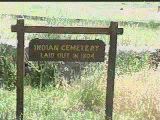 Click
here
to see a video of the Indian Cemetery
Click
here
to see a video of the Indian Cemetery
The story of the
Indians
at this mission
begins on the day of Father Serra's first mass. A curious Indian boy
watched the mass that dedicated Mission San Antonio de Padua.
Afterwards Father Serra offered him gifts. He treated the Indian so
kindly that he brought members of his tribe to meet Father Serra.
These friendly Indians were always helpful and loyal through all the
years that San Antonio was a working mission. In 1774, there were 178
Indians living at the mission. By 1805, the total was 1,300. In 1834
after the secularization laws went into effect, the total number of
Indians at the mission was only 150.
Back
to the top
Economy of the mission
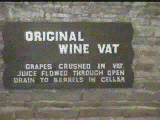 Click
here
to see a video of the original wine vat and cellar
Click
here
to see a video of the original wine vat and cellar
The economy at
Mission
San Antonio de Padua
was similar to the other missions in that they planted crops of wheat
and corn. They also planted vineyards, and raised cattle and sheep.
The agriculture was needed not only to maintain the mission community
and the nearby Indians, but was used for trade and served to visitors
to the mission. Some of the shops at the mission were a weavery, a
room for carding and spinning wool, a tannery for treating leather, a
carpenter shop, a stable, and a harness shop.
Back
to the top
The
community
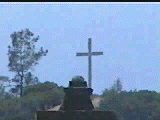 Click here
to
see a video Inside the Mission Quadrangle
Click here
to
see a video Inside the Mission Quadrangle
Mission San Antonio
is
one mission which
grew rapidly and maintained itself very well. The mission was self
supporting and self sufficient. However, no town grew up around the
mission as so many did at the other missions. Today the nearest city
is King City, nearly 29 miles away. Jolon, a small town, is 6 miles
from the mission. The mission padres and Indians built their own
buildings and lived peacefully for many years.
Back
to the top
Secularization
After Mexico won its
independence from
Spain, it found that it could no longer afford to keep the missions
running as Spain had done. In 1834, Mexico decided to end the mission
system and sell all of the lands. They offered the lands to the
Indians who did not want the lands or could not come up with the
purchase price. The lands were divided into smaller Ranchos and sold
to Mexican citizens who were helpful during the war for independence.
In 1845, Governor Pio Pico declared Mission buildings for sale and no
one even bids for San Antonio. After nearly 30 years, the missions
were returned to the Catholic Church. Although some of the missions
had already been returned to the church, in 1863, President Abraham
Lincoln signed an Act declaring that all of the 21 missions in the
California mission chain would become the property of the Catholic
Church and have remained so since that time.
Back
to the top
Rebirth
The first attempt at
rebuilding the mission
came in 1903, when the California Landmark League rebuilt the church
walls. It took nearly 50 years to completely restore the mission. In
the 1940's, The Hearst Foundation gave the church $50,000 for
repairs. In 1928, Franciscan Friars returned to San Miguel and also
held services at San Antonio de Padua.
Back
to the top
Current use
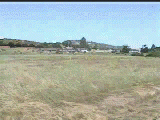 Click
here
to see a video of the Fort Hunter Liggett Military
Reservation
Click
here
to see a video of the Fort Hunter Liggett Military
Reservation
The Mission is
surrounded
by the Fort Hunter
Liggett Military Reservation which was acquired by the Army from
Hearst during World Was II to train troops. Additional land was
acquired from the Army in 1950 to bring the total mission acreage to
over 85 acres. This fort is still actively training troops today.
Back
to the top
Graphic tour
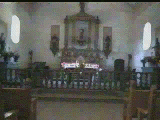 Click
below
to see a video Inside the Mission Church
Back
to the top
Click
below
to see a video Inside the Mission Church
Back
to the top
Assessment
Mission
Quiz
Objective:
answer 7 questions correctly. JavaScript
required!
1.
Who was the founder of
Mission San Antonio de Padua?
Juan
Bautista de Anza
Gaspar
de Portola
Junipero
Serra
Sebastian
Vizcaino
2.
Mission San Antonio de Padua was founded....?
July 14,
1771
September
21, 1769
May 5,
1783
June 14,
1804
3.
Who was left in charge to start the Mission?
Fr.
Miguel Pieras
both a
and c
Fr.
Buenaventure Sitjar
Fr.
Junipero Serra
4.
When was the final church structure started?
1771
1810
1834
1769
5.
Who did the actual building of the missions?
construction
companies
the
priests
the
soldiers
the
local Indians
6.
What happened to the missions in 1834?
They
opened
The
Indians took over
Secularization
nothing
7.
Who began rebuilding the church in 1903?
Local
Indians
California
Mission Rebuilding
Society
California
Landmark League
Franciscan
Priests
8.
What is the name of the military reservation
surrounding the
Mission?
Camp
Pendleton
Navajo
reservation
Fort
Hunter Liggett Reservation
Father
Serra Reservation
9.
What happened in 1928?
An
earthquake
Secularization
Missions
were returned to the
Catholic church
Franciscan
Friars returned to San
Miguel and held services at San Antonio de Padua
10.
What did Abraham Lincoln agree to in 1863?
Formally
return the Mission lands to
the Church
Run for
President of the United
States
Visit
the San Antonio de Padua
Mission
force
the Indians to leave the
Mission
Back
to the top
The
Mission
Page | The
Assessment Page
|Main Page
Other San Antonio de
Padua
sites:
The
Spanish Missions of California
California
Missions Interactive Homepage
California
Missions
Summary
History of Mission San Antonio de Padua
- History of the foundation of the Mission
and
construction of the earliest church, its replacement by later
structures, its decay after secularization and eventual
reconstruction. Bibliography.
Summary
History of the San Antonio Valley -
How the San Antonio Valley was bypassed by the railroad and later
highway development, thus preserving intact its rural isolation and
many of the historic structures in it.
This project written by Rob
Garretson in
partial fulfilment of
the Master's
of Arts Degree
from Cal
Poly
Pomona
Please send
questions
and/or comments to Mr.
Garretson
This page last
updated on February 28, 2015